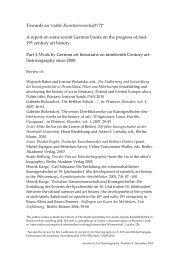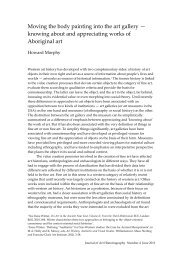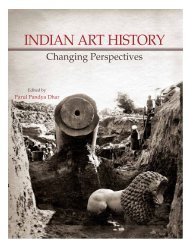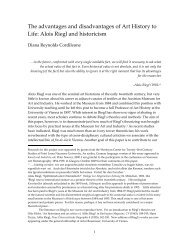9/CCG1 - Journal of Art Historiography
9/CCG1 - Journal of Art Historiography
9/CCG1 - Journal of Art Historiography
You also want an ePaper? Increase the reach of your titles
YUMPU automatically turns print PDFs into web optimized ePapers that Google loves.
Carolyn C. Guile<br />
Winckelmann in Poland: An Eighteenth-Century<br />
Response to the ‘History <strong>of</strong> the <strong>Art</strong> <strong>of</strong> Antiquity’<br />
that art developed in a cyclical, uneven manner across cultures, and that art itself<br />
provided the visual evidence for the progress, stasis, and decline <strong>of</strong> culture with<br />
standards <strong>of</strong> beauty and habits <strong>of</strong> innovation serving as evidence, Potocki seemed<br />
most interested in beauty as the object <strong>of</strong> art, and Beauty in the Platonic sense - not<br />
relative but rather comprehended to a greater or lesser degree from one region to<br />
the next. In certain regions, he held, art never progressed beyond a certain point.<br />
The division was for him a clear one between western and eastern art, whose<br />
character was completely different: ‘while one – that is the Western – aims at<br />
perfection, the Eastern, having stopped at a certain point, stand still at this point,<br />
immobile, and so they remain today as they were thousands <strong>of</strong> years ago.’ 68 In other<br />
words, cultures did not develop at the same rates alongside one another; cultural<br />
stagnation was observable and measurable in art itself. At the same time it is<br />
impossible, he notes, to deny that<br />
The East was first in art….From the most ancient times, the science<br />
and wisdom <strong>of</strong> the east was well known. Nations polished and<br />
powerful blossomed there, when Europe was covered in forests and<br />
under their shadows it fed its inhabitants with nuts and acorns. It is<br />
therefore impossible not to admit that eastern people were the first to<br />
create patterns <strong>of</strong> art for imitation. 69<br />
But he reserved the perfection <strong>of</strong> art for the West ‘as though nature wanted to make<br />
it up to the West for this handicap.’ 70 Chapter one, ‘On the Beginnings <strong>of</strong> <strong>Art</strong> and<br />
Reasons for Difference Between the <strong>Art</strong>s <strong>of</strong> the Occidental and Oriental People’<br />
translates and paraphrases Winckelmann’s first chapter, ‘Origin <strong>of</strong> <strong>Art</strong> and Reasons<br />
for its Diversity Among Peoples.’ <strong>Art</strong>, explains Potocki, ‘defined the measure and<br />
limit <strong>of</strong> human perfection which human understanding could not exceed.’ 71<br />
Winckelmann’s work introduces the art <strong>of</strong> ancient Egypt before discussing that <strong>of</strong><br />
the Greeks; he returns to the subject <strong>of</strong> the transmission <strong>of</strong> art to the Greeks by the<br />
Phoenicians and then the Egyptians, and closes the section on the cultural<br />
transmission <strong>of</strong> forms across geography with an explanation for the similarity<br />
between Egyptian and early Greek figures. Here, Potocki followed Winckelmann’s<br />
68 ‘jedne, to jest zachodnie, dążą do wydoskonalenia, wschodnie stanąwszy na pewnym punkcie, na<br />
nim nieruchome stoją i takiemi dziś są, jakiemi przed lat tysiącami były.’ Potocki, O Sztuce u Dawnych,<br />
1: 78.<br />
69 Przecięz Wschodowi zaprzeczyć w sztukach pierwszości niepodobna…Od najdawniejszych czasów<br />
sławną była Wschodu nauka i mądrość. Kwitnęły tam narody wypolerowane i potężne, kiedy Europa<br />
lasami okryta, pod ich cieniem żołędzią dzikich karmiła mieszkańców. Nie można więc nie przyznać<br />
ludom wschodnim, że one pierwsze światu znane, pierwsze nam sztuk zostawiły wzory.’ Potocki, O<br />
Sztuce u Dawnych, 1: 77.<br />
70 ‘Lecz jakby chciała natura wynagrodzić Zachodowi to upośledzenie, jemu ich wydoskonalenia<br />
przeznaczyła zaszczyt.’ Potocki, O Sztuce u Dawnych, 1: 77.<br />
71 ‘Miała [sztuka], jak ma wszystko, zakreśloną miarę i granice stanowiące jej doskonałość, których<br />
przestąpić pojętności człowieka danym nie było.’ Poticki, O Sztuce u Dawnych,1: 73.<br />
19
















